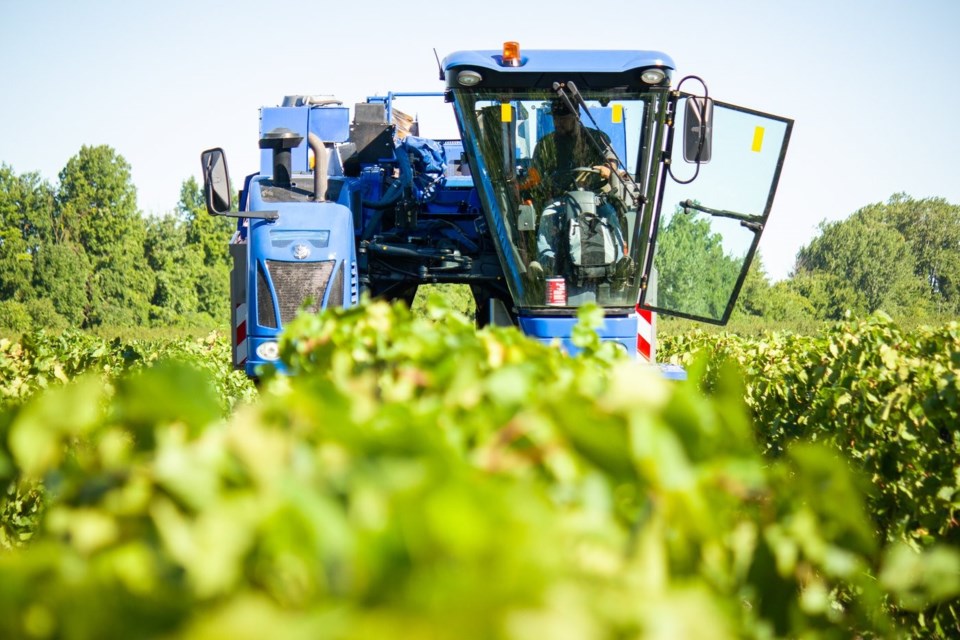The harvest has begun at Huebel Grapes in Niagara-on-the-Lake.
Long, bustling days for Huebel's staff will be the norm until the end of October. Between now and then, around 3,000 tonnes of grapes, made up of at least 10 varieties, will be harvested across 750 acres of vineyards spanning from the Niagara escarpment to the peninsula’s lake shore.
On this day, the sun is shining from a pale blue sky padded with clouds, and the temperature hovers in the low twenties—perfect harvesting weather.
Jessica Oppenlaender steers her father’s pickup truck across a bumpy pathway bordering the Queenston vineyard’s perimeter.
She’s searching for an awkward looking, blue machine known as a harvester.
At 1.2 acres, the Queenston vineyard is a Huebel original, having been planted by Otto Huebel in 1983.
Matthias Oppenlaender, CEO of Huebel Grapes Estates, started working for Huebel in 1984 after arriving in Canada from Germany that same year.
He’s been at it ever since, becoming a partner with Huebel in 1991.
Since 1983, another several hundred acres have been planted, and the operation also contracts its services out to local growers.
Now in his late fifties, Matthias has raised five children. All of them are wrapped up in the vines one way or another.
Jessica is the youngest of the bunch and was married only two weeks ago to her high school sweetheart.
She’s now finishing up her final year in the oenology and viticulture program at Brock University. This is her first harvest working at the family operation.
She spots the harvester crawling somewhere along rows one and nine, which are laden with red Frontenac grapes.
The harvester straddles a vine row while being piloted by a migrant worker from Mexico. He sits in a cab high above four large treaded tires rolling along the pathways between rows.
As the harvester moves from one end of a row to the other, the vines are shaken vigorously causing the grapes to drop into buckets. The grapes are then fed on a conveyor belt into holding bins on the machine.
Mike, one of Jessica’s brothers, waits at a nearby tractor-trailer. The grapes will finally be dumped into bins lining the flatbed and driven by Mike to Andrew Peller Ltd. where the fruits of their labour will be turned into wine.
Still speaking with a heavy German accent, Matthias says Niagara’s wine industry has come to stand on its own over the past few decades.
“When I started, people didn’t know we could grow the grapes we do,” he said. “When I first came nobody wanted to drink an Ontario wine.”
At a nearby vineyard, workers snip the stems of chardonnay clusters, dropping them into bins below.
The bins are gathered onto a trailer and taken to be cooled before meeting their destiny as sparkling wine.
White grape varieties mature faster than reds, so they’re picked first when their brix (sugar) content and acidity is in balance.
Jessica refers to the grapes as being “flavour ripe.”
“For sparkling, you want to whole-bunch press them, you don’t want them to crush each other and oxidize,” she explained. “By picking them by hand, we get those whole bunches.”
So far, this year’s overall yield is below average, Matthias says, blaming the 20-25 per cent decrease on drought conditions. Last year saw one of the highest yields on record, which tends to weaken the following year’s output.
But the season isn’t over yet. It won’t peak until mid to late September, and growing grapes is an endurance exercise best practised with patience.
Yields may be down, but if weather remains dry and mild, the season can be drawn out, allowing some varieties to hang on and mature into a high-quality vintage grape; potentially making 2020 into a “century vintage,” as they say in Germany, and ironically, a good year to look back on—at least when it comes to vintage wines.



